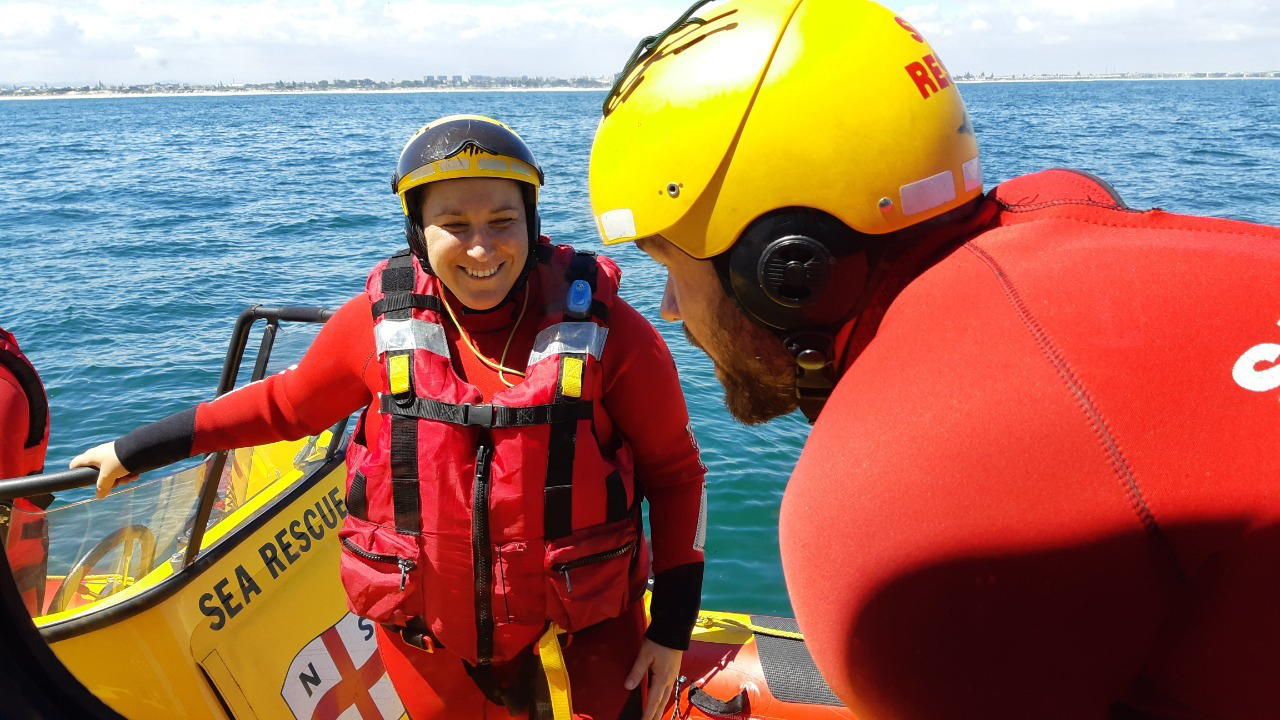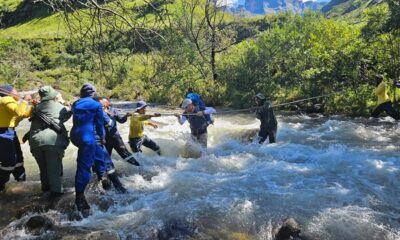
Community

Superheroes of the Cape of Storms
They’ve seen people drown, and rescued people in gale force winds and on summer days. They’ve thrown themselves into icy oceans, taken ill sailors off ships, and even untangled whales from nets. They all have jobs, businesses, and family commitments, yet spend hours training and saving lives in a dangerous environment. They’re members of the National Sea Rescue Institute (NSRI), keeping the coastline safe for everyone who ventures into the water.
Luke van Riet (34) is one of a number of Jewish volunteers who serve at NSRI stations up and down the Cape peninsula. The organisation operates around South Africa. One of his most harrowing experiences was rescuing people from a trawler that ran aground on Robben Island. “There was a mid-winter storm with massive seas, heavy rain, and dark skies. We evacuated all 18 crew safely at midnight.”
Robyn Silverstone (38) has been volunteering for more than two decades. “I had exposure to the NSRI when I did the gemilut chasidim project [acts of loving kindness community service project] in Grade 10 at Herzlia. I did my 10 hours of community service and never left. Twenty-one years later, I’m still there.”
She was part of the team that rescued people from one of the Cape’s worst sea disasters in recent times, the capsizing of tourist boat Miroshga in 2012. “Casualties were trapped inside. After a lengthy, multi-resource operation, we were successfully able to extricate them from a small compartment,” she says.
Gal Chiles (24) has always been passionate about the sea, and like Silverstone, he volunteered for the NSRI during his gemilut chasidim project and also never left. Now he heads up a team at the Table Bay station. Anyone who has walked into the busy Victoria & Alfred Waterfront would have noticed how the NSRI station is located in the middle of a busy port. It was when he was there doing some administration that Chiles experienced his most intense call-out – rescuing people from a Robben Island ferry that was taking on water.
“The Thandi ferry was struggling in bad weather conditions and sharp swells. There were 68 people in distress. There was a look of terror on their faces. It was overwhelming, but our training kicked in. We safely evacuated everyone.”
Silverstone was there, co-ordinating the evacuation. “A terrible sea state and a boat sinking with 68 people on board tends to cause a bit of stress, but thanks to our training and experience, we’re well-prepared and calm when handling these life-threatening situations,” she says.
Van Riet joined NSRI as a volunteer in 2007 after close to a decade of surf lifesaving. “The NSRI felt like the next step in emergency water rescue. I haven’t looked back for 15 years.”
Today, he’s a station commander. “As with all well-run organisations, you start from the bottom and build a foundation,” he says. “You start as a trainee and your immediate next goal is crewman. Once you are crew, which can take one to two years, you’re able to respond to active operations known as call-outs. This is where the real training comes into play and life experience is built.
“After six years as crew and after attending courses, accumulating the required sea-going hours, and fulfilling criteria, I was examined and promoted to a coxswain. The coxswain is the skipper of the vessel and crew leader. You’re in charge of operations or whenever the boat gets put to sea. The success of an operation is largely on your shoulders. In many ways, the safety of the crew is in your hands. You’re entrusted with expensive assets and tasked with the impossible.
“Three years ago, I was elected as station commander for our rescue base. It’s a very tiring, demanding, and important role in which there’s no room for half measures and anything less than perfect. I’m responsible for all assets, the crews’ well-being, and the continual development of the organisation. We’re donor-funded and therefore have a responsibility to respect every rand and cent, as well as be available to respond to any emergency within minutes, 24/7, 365 days a year.”
They are called out “at night, in winter storms, in strong south easterly winds, and on peachy summer days”, says Van Riet. “We generally attend to a drowning in progress, boat tows, missing kayakers, injuries along the coastline, divers in trouble, whale disentanglements, injured seals, beached whales … the list goes on.”
They’re all driven by the joy of helping others. “Knowing that I and my crew are saving lives as volunteers definitely motivates me,” says Silverstone. “A simple thank you from the casualties is also a huge motivator. Gemilut chasidim sits high on my radar.”
“The goose bumps you get when you look into someone’s eyes after you save their life, to know that without your intervention, their soul would be left at sea [is motivation],” says Van Riet. “Sadly, we can’t always save our casualties. They succumb before we arrive, but we’ll always try to retrieve them so the family can lay them to rest.
“What’s better than making such a life-saving difference while developing the most incredible skills and passing your knowledge on to future volunteers so that the legacy can go on? asks Van Riet.
“To see the look of desperation on someone’s face and then see their relief that they know you’re coming to help them is very meaningful,” says Chiles. “It makes me want to keep coming back.”
Being in the ocean is a powerful part of the experience. “We see lots of ocean life, and we’re lucky to be surrounded by friendly dolphins and whales who tend to navigate towards us,” says Silverstone. “The sea is a dangerous place and one has to respect it. It can change in a second, and if you’re not prepared, there’s a high probability of things turning south fast, but that’s why we’re there.”
“Global warming is evident,” says Van Riet. “The ferocity of storms has increased over the years. We have had to put measures in place to protect our base from larger storms each year. Sea life is taking a beating from over-fishing and an overbearing human presence. More whales are being entangled in nets, and pollution is getting more concentrated along the coastline and in the deep.”
They have all had to make sacrifices. “You need to be aware of your plans while on call and make sure that you’re within 20 minutes of the station. Once, I had to run out on Rosh Hashanah,” says Silverstone. “Losing family time, free time, and time away from work [is tough],” says Van Riet. “Once you reach the level of station commander, a lot falls to the side, as your priority is to ensure your station and crew are running at maximum capacity all the time without exception.”
But they all feel part of a sea-rescue family which keeps each other going. “You trust each other so much. I know they will always have my back,” says Chiles. “You develop serious friendships. I can’t imagine the person I would be if I hadn’t joined the NSRI. It has given me purpose. It was the best decision I ever made.”










